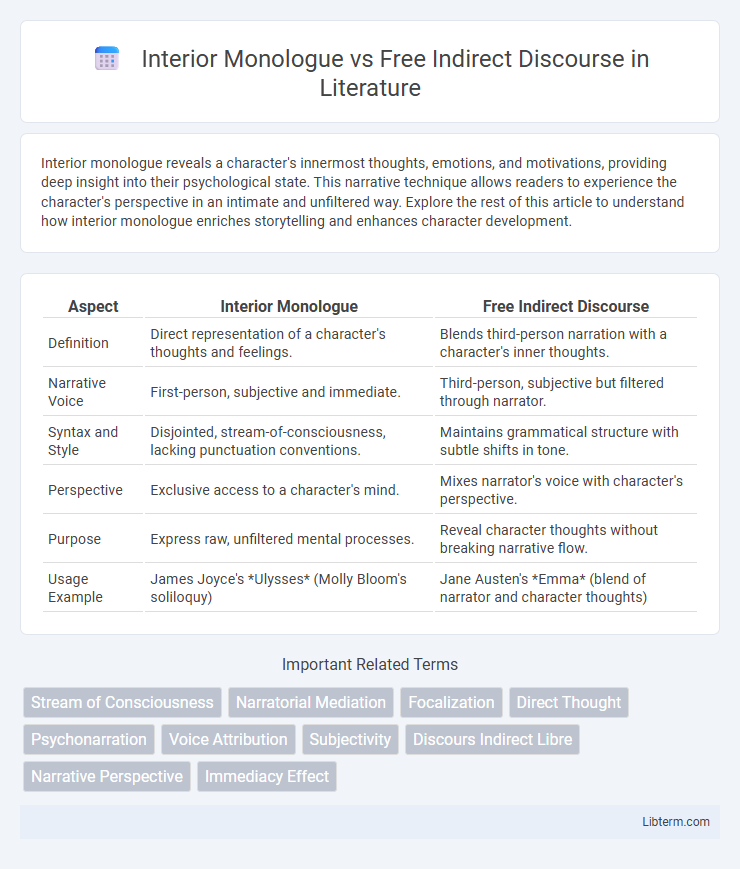Interior monologue reveals a character's innermost thoughts, emotions, and motivations, providing deep insight into their psychological state. This narrative technique allows readers to experience the character's perspective in an intimate and unfiltered way. Explore the rest of this article to understand how interior monologue enriches storytelling and enhances character development.
Table of Comparison
| Aspect | Interior Monologue | Free Indirect Discourse |
|---|---|---|
| Definition | Direct representation of a character's thoughts and feelings. | Blends third-person narration with a character's inner thoughts. |
| Narrative Voice | First-person, subjective and immediate. | Third-person, subjective but filtered through narrator. |
| Syntax and Style | Disjointed, stream-of-consciousness, lacking punctuation conventions. | Maintains grammatical structure with subtle shifts in tone. |
| Perspective | Exclusive access to a character's mind. | Mixes narrator's voice with character's perspective. |
| Purpose | Express raw, unfiltered mental processes. | Reveal character thoughts without breaking narrative flow. |
| Usage Example | James Joyce's *Ulysses* (Molly Bloom's soliloquy) | Jane Austen's *Emma* (blend of narrator and character thoughts) |
Understanding Interior Monologue: Definition and Features
Interior monologue represents a direct, unmediated expression of a character's inner thoughts and emotions, often presented in the first person and maintaining the character's unique voice and psychological depth. This narrative technique immerses readers in the subjective experience by capturing spontaneous, fragmented, or continuous streams of consciousness without external narration or interpretation. Unlike free indirect discourse, which blends third-person narration with a character's perspective, interior monologue offers an intimate, explicit articulation of internal mental states, providing a deeper access to the character's psyche.
What is Free Indirect Discourse? Key Characteristics
Free indirect discourse is a narrative technique that blends the character's thoughts and feelings with the third-person narrator's voice, creating a seamless merging of perspectives. Key characteristics include the absence of quotation marks, shifting verb tenses to reflect the character's viewpoint, and the use of language that captures the character's personal thoughts without explicit attribution. This technique allows readers direct access to a character's inner experiences while maintaining the narrative's external perspective.
Historical Origins and Literary Evolution
Interior monologue emerged in the early 20th century, pioneered by writers like James Joyce and Virginia Woolf, emphasizing direct access to characters' thoughts and emotions. Free indirect discourse, traced back to Gustave Flaubert's 19th-century novels, blends third-person narration with a character's inner voice, enabling a subtle, layered perspective. Both techniques evolved to deepen psychological realism, influencing modernist and postmodernist literature by breaking traditional narrative boundaries.
Narrative Perspective: First-Person vs Third-Person
Interior monologue presents a narrative perspective rooted in first-person, allowing direct access to a character's thoughts and feelings in their own voice, creating intimate psychological depth. Free indirect discourse merges third-person narration with the character's internal thoughts and speech without quotation marks or first-person pronouns, blending external observation with subjective insight. This technique enables a seamless shift between narrator and character perspective, enriching narrative complexity while maintaining third-person viewpoint.
Psychological Depth: Accessing Character Consciousness
Interior monologue provides direct access to a character's unfiltered thoughts and emotions, immersing readers deeply into their psychological state. Free indirect discourse blends the narrative voice with the character's inner thoughts, offering subtle insight into consciousness without overtly breaking the narrative flow. This technique enables nuanced psychological depth by merging external narration and internal experience, enriching character complexity.
Syntax and Style: Structural Differences Explained
Interior monologue employs fragmented, unpunctuated syntax to replicate a character's raw, subjective thought process directly, often reflecting emotional intensity and spontaneity. Free indirect discourse blends third-person narration with the character's voice, maintaining grammatical conventions while subtly infusing personal thoughts and feelings, creating a seamless narrative flow. These stylistic distinctions influence how readers engage with characters' inner experiences, with interior monologue offering intimate immediacy and free indirect discourse providing an integrated, nuanced perspective.
Notable Authors and Iconic Literary Examples
Interior monologue, exemplified by James Joyce's *Ulysses*, offers a direct, unfiltered flow of a character's thoughts and sensations, immersing readers in intimate psychological experience. Free indirect discourse, masterfully utilized by Jane Austen in *Pride and Prejudice*, blends third-person narration with a character's inner voice, creating a seamless shift between external description and subjective reflection. Virginia Woolf's *To the Lighthouse* illustrates both techniques, showcasing her innovative narrative style that captures complex consciousness through layered interior perspectives.
Advantages and Limitations in Storytelling
Interior monologue offers direct access to a character's unfiltered thoughts, enhancing psychological depth but can disrupt narrative flow with its intensity. Free indirect discourse blends character voice with third-person narration, allowing seamless shifts in perspective while maintaining narrative distance, though it may obscure the source of some thoughts. Both techniques enrich storytelling by deepening character insight but vary in clarity and reader engagement depending on their implementation.
Reader Engagement: Immersion and Interpretation
Interior monologue provides direct access to a character's thoughts, creating intense reader immersion by presenting unfiltered mental experiences and emotional states. Free indirect discourse blends the character's voice with the narrator's perspective, allowing readers to interpret subtle shifts in tone and bias, enhancing engagement through nuanced interpretation. This narrative technique encourages active reader participation in deciphering character motivations and subjective realities.
Choosing the Right Technique for Your Narrative
Choosing between interior monologue and free indirect discourse depends on your narrative goals and the desired depth of character insight. Interior monologue offers direct access to a character's unfiltered thoughts, ideal for intense emotional or psychological exploration, while free indirect discourse blends the narrator's voice with the character's perspective, maintaining narrative cohesion and subtlety. Writers should consider the balance between immediacy and narrative distance to effectively immerse readers in a character's inner world without disrupting the story's flow.
Interior Monologue Infographic

 libterm.com
libterm.com